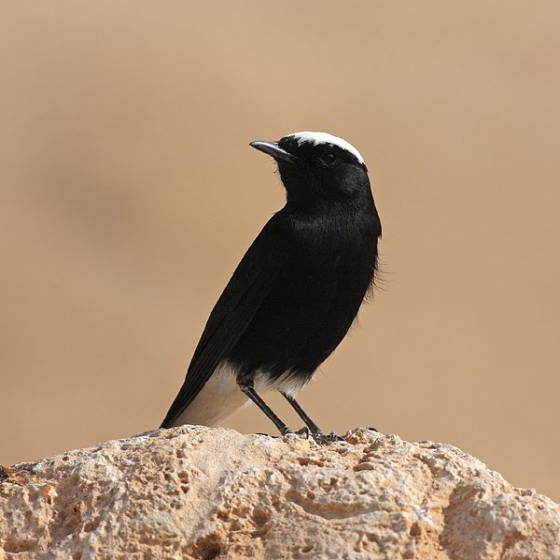White-crowned Black Wheatear

Introduction
A bird of hot, dry habitats in North Africa and the Middle East, White-crowned Black Wheatear is generally sedentary in its habits.
An extremely rare visitor to Britain, added to the British List following one at Kessingland, Suffolk, in June 1982.

Key Stats
Status and Trends
Conservation Status
Population Size
Population Change
Population trends of this scarce species are not routinely monitored.
Distribution
This vagrant has not been recorded in the UK for many decades and as such cannot be mapped.
Distribution Change
This vagrant is too rarely reported to map distribution change.
Seasonality
This species has been too rarely reported to BirdTrack during 2011–22 to properly assess seasonality.
Movement
Britain & Ireland movement
Biology
Survival and Longevity
Survival is shown as the proportion of birds surviving from one year to the next and is derived from bird ringing data. It can also be used to estimate how long birds typically live.
Classification, names and codes
Classification and Codes
- Order: Passeriformes
- Family: Muscicapidae
- Scientific name: Oenanthe leucopyga
- Authority: CL Brehm, 1855
- BTO 5-letter code: WHCBL
- Euring code number: 11570
Alternate species names
- Catalan: còlit tuareg
- Czech: belorit pustinný
- Danish: Hvidkronet Stenpikker
- Dutch: Witkruintapuit
- Estonian: tanu-kivitäks
- Finnish: kalottitasku
- French: Traquet à tête blanche
- German: Saharasteinschmätzer
- Hungarian: koronás hantmadár
- Icelandic: Helludepill
- Irish: Clochrán dubh bánchorónach
- Italian: Monachella nera testabianca
- Latvian: baltgalvas cakstite
- Lithuanian: sacharinis kultupys
- Norwegian: Hvitkronesteinskvett
- Polish: bialorzytka saharyjska
- Portuguese: chasco-de-barrete-branco
- Slovak: skaliarik ciapockatý
- Slovenian: beloglavi kupcar
- Spanish: Collalba yebélica
- Swedish: vitkronad stenskvätta

